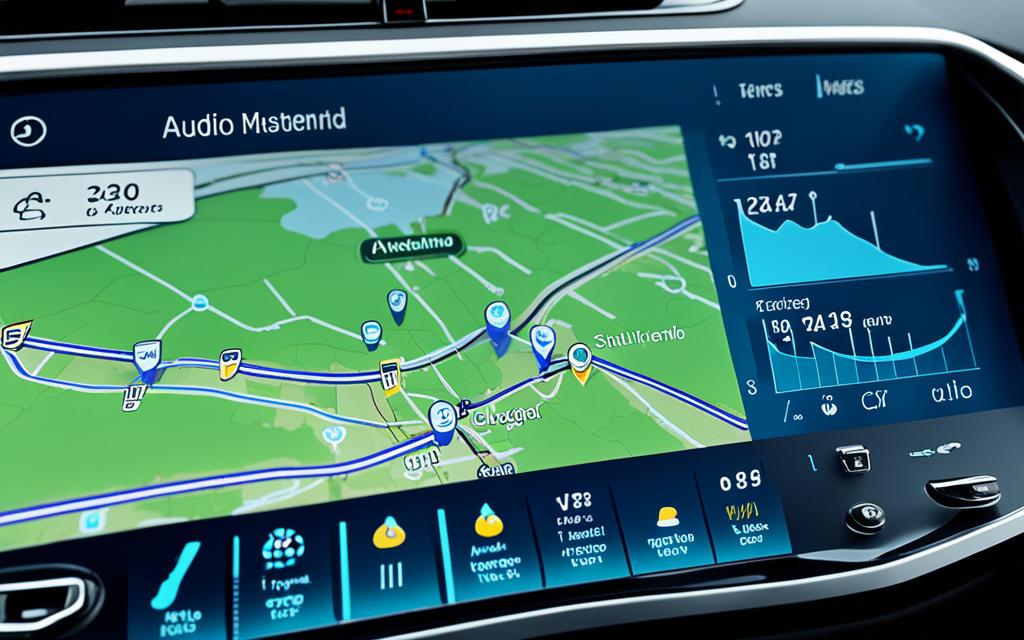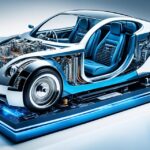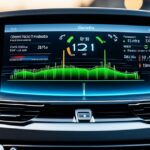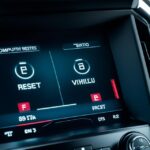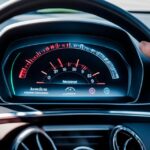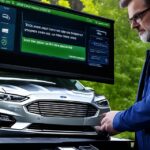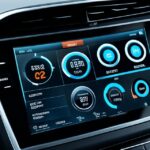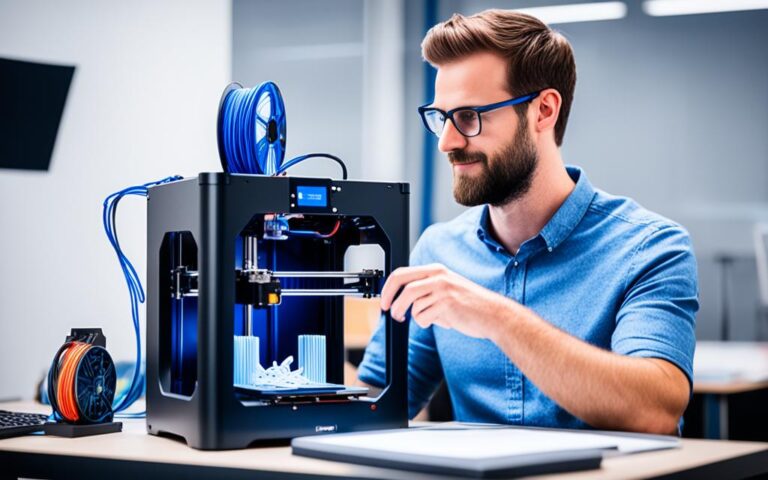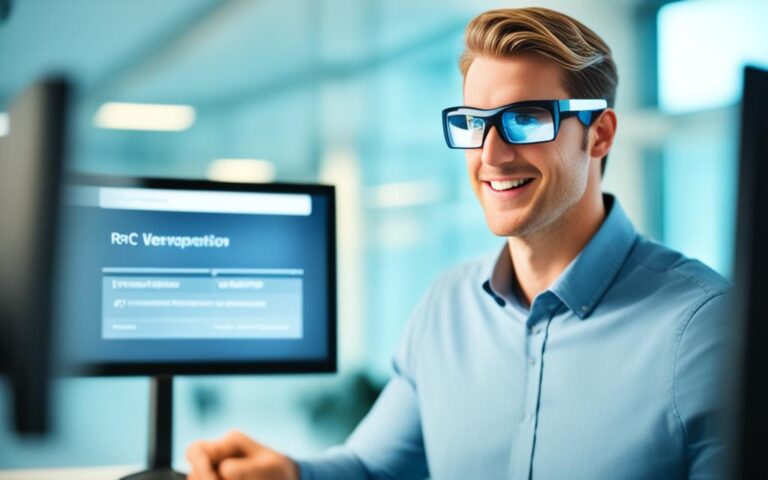The journey of car technology has seen many key moments that have changed how we drive. It started with Karl Benz making the first motor car in 18861. Then, electric ignition starters came in 19111, marking a big step forward.
In 1913, Ford Motor Company changed car making with the moving assembly line1. This made cars cheaper and easier to get for everyone.
Over the 20th century, cars got better and better. In 1933, the first car radio was introduced by Galvin Manufacturing1. The 1950s brought power steering and seat belts, making driving safer.
The late 20th century saw cars get smarter. In 1988, Chrysler made the first airbag1, which helped keep passengers safe. The 1990s brought on-board diagnostic computers1, helping with car maintenance.
At the start of the 21st century, we saw big changes. The Toyota Prius introduced hybrid motors in 20001. These engines use less fuel and produce fewer emissions. In 2014, Elon Musk launched the first autopilot technology in the Tesla Model S1, moving us towards self-driving cars.
Key Takeaways:
- The origins of in-car computers can be traced back to the invention of the first motor car by Karl Benz in 18861.
- Throughout the 20th century, significant milestones included the introduction of the moving assembly line, car radios, and safety features such as power steering and seat belts1.
- The integration of digital technology in the late 20th century paved the way for advancements such as on-board diagnostic computers and hybrid motors1.
- In the 21st century, autopilot technology has emerged as a game-changer in the automotive industry, bringing us closer to fully autonomous driving1.
The First Digital Screen in Cars (1976)
In 1976, Aston Martin changed the game by adding the first digital screen to cars. This changed how drivers and passengers saw information.
The Aston Martin Lagonda sedan was the first car to show information on a digital screen. It showed things like speed, fuel levels, temperature, RPM, and time. This used five cathode ray tube (CRT) screens2.
Even though Aston Martin’s digital screen was a big step forward, it was too expensive. This made it hard for others to use it2.
Still, Aston Martin’s early work set the stage for more digital screens and car tech. Later, more affordable and better displays changed the way we drive for the better2.
The Rise of Digital Displays (1980s)
In the 1980s, LCD digital displays changed the car industry. They changed how drivers and passengers saw information. Touchscreen technology was a big step forward, making in-car displays better3. This section looks at how these displays became common in luxury cars and changed the driving experience.
At the start of the 1980s, LCD technology changed digital screens. LCD screens were lighter, looked better, and were cheaper than CRT screens. Luxury car makers loved this new tech. They used LCD digital displays to show off luxury and innovation4.
Early LCD displays showed things like the radio, fuel use, and temperature. The screens were small, from tiny to medium-sized3.
The Twisted Nematic LCD came out in the 1980s and made LCD screens better. It made them faster and clearer, making them more popular with car makers and buyers3.
During this decade, some cars showed what digital displays could do. The 1986 Oldsmobile Incas concept had a big screen for all the controls, making driving easier4.
Other cars, like the Lamborghini Athon, showed off their digital features. They had screens for GPS, climate control, and more4.
The 1980s also brought infotainment features to luxury cars. Touchscreens were key, starting with the Buick Riviera in 1986. It had features like climate control and audio settings3.
But, touchscreens were not accepted right away. People worried they would distract drivers. So, it took a while for them to become common in cars3.
Still, the 1980s set the stage for today’s car displays. These early steps changed the way we drive, making LCD digital displays a key part of modern cars4.
References:
- The rise of touchscreen displays in new cars: 82% of vehicles sold in 2019 had touchscreens. These screens have grown from 10 inches to over 56 inches. Early car displays showed basic info like radio and fuel use. Touchscreens started in 1986 but were slow to catch on due to distraction concerns; they became popular again in the early 2010s.
- The 1986 Oldsmobile Incas concept had a full-width panel with many screens. The 1980s Lamborghini Athon had electronic readouts for a unique look. Volkswagen’s 1986 Orbit concept had a cutting-edge dashboard with an “Infovision Processor” and CD player. The Nissan CUE-X concept, from 32 years ago, had a colorful screen for GPS, climate, and more. The Peugeot Quasar concept from 1984 had a color screen for navigation and messaging. The Aston Martin Lagonda Series II in 1976 used three 5-inch CRT screens for a futuristic feel. Mazda’s 1985 MX-03 concept had a digital dash, a jet fighter wheel, and more. Toyota’s 1984 Cressida had a wide panel with big, easy-to-read screens. The Toyota Soarer had an “Electro Multi Vision” display with different modes and TV capabilities. The Volvo Tundra had a dual digital dash in 1979, similar to today’s Mercedes models. The Opel Monza GSE from 1983 had LCD screens, including a rev counter and four bars. The Buick Reatta had a touchscreen in 1988, a rare feature at the time. The Subaru XT 4WD 1800 Turbo had an arcade game-style dash as an option. Alfa Romeo’s Quadrifoglio Oro had a digital dash with a trip computer. The Isuzu Piazza had a retro-futuristic dash that moved with the wheel. The Toyota Celica 2.0 GT-R had a unique digital dash design. The Vector W8 had four screens of info, showing the tech level of the early 1990s. The Chevy Corvette C4 had a standard LCD panel, but it had reliability issues, still marking a big step in digital dashboards.
The Introduction of TFT LCDs and GPS Displays (1990s)
In the 1990s, a big change happened with the arrival of Thin-Film-Transistor (TFT) LCDs. These displays were thinner and used less energy, changing how we see things in everyday products5. They used the active matrix concept to make images clearer and more vibrant.
“The introduction of TFT LCDs in the 1990s changed how we see things in products, making them thinner and more energy-efficient. Their active matrix concept greatly improved image quality by providing current to individual pixels.”
– Reference5
At the same time, GPS displays started to appear in cars. These used Global Positioning System (GPS) tech to show drivers where they were and how to get where they were going6. This made driving easier and safer.
TFT LCDs and GPS displays changed the car tech world in the 1990s. They made driving better and paved the way for more car tech improvements.
TFT LCDs: A Shift towards Thinner and More Energy-Efficient Displays
TFT LCDs came out in the 1990s and were a big step up from old CRT displays. They used less power, took up less space, and were lighter. This made them perfect for portable devices5. These benefits helped LCDs become the top choice for many industries.
Prices for LCD monitors went down a lot in the 1990s. By 1997, they were affordable for more people. This made LCD tech more popular in homes and offices5.
“The lower power consumption, reduced space requirements, and lighter weight of TFT LCDs made them more suitable for portable devices. Additionally, the decreasing prices of LCD monitors in the late 1990s led to their widespread adoption in the consumer and professional markets.”
– Reference5
By 2003, TFT-LCDs had become the main type of display for computer monitors. This showed how popular LCD technology had become5.
The early 1990s saw the first LCD computer monitors come out. The Eizo L66, Apple’s Studio Display in 1998, and Cinema Display in 1999 were some of the first. These displays were the start of something big in LCD technology5.
GPS Displays: Empowering Drivers with Navigation Assistance
GPS displays in cars in the 1990s were a big step forward in navigation. Car makers started adding GPS as a standard feature. These displays showed where you were, had maps, and gave directions, making driving easier and less confusing6.
GPS displays quickly became a hit, especially in aviation. They helped pilots navigate better and more safely6. This made flying safer and more reliable.
The GPS market grew a lot during this time. This was because more people wanted car navigation systems and the aviation industry needed GPS6. This showed how well GPS displays were received and their growing role in different areas.
The 1990s were a big time for in-car technology with TFT LCDs and GPS displays. These innovations led to the advanced car tech we have today.
Touchscreens and CD Players (2000s)
In the 2000s, LCD technology changed the car industry. It made touchscreens and CD players very popular.
TFT LCDs brought digital screens to cars, replacing old CRT screens7. These new screens showed clearer images and colors, making them easier to see. This made driving more enjoyable.
Touchscreens let drivers and passengers control the car’s entertainment easily. They could use the screen for music and other features. CD players worked well with touchscreens, making listening to music a breeze.
CD players became a must-have in cars in the 2000s7. They could play CDs and MP3s, letting drivers enjoy their favorite tunes on the move7. These players got better at reading discs and sounded clearer, making music in cars better than ever.
Touchscreens and CD players changed how we enjoy music in cars. They made controlling the music and other features easy and fun.
Hands-free Bluetooth calling started in the early 2000s, making driving safer7. It let drivers talk on the phone without taking their hands off the wheel.
Ford Sync came out in 2007 and changed the game. It let drivers make calls and control music with just their voice7.
In the 2010s, Apple CarPlay and Android Auto became big news7. They let smartphones connect to car screens. This meant drivers could use their favorite apps, get directions, and listen to music all from the car.
The 2000s were a big time for car tech. Touchscreens and CD players made driving easier and more fun for everyone.
The Present and Future of In-Car Displays
Modern cars now come with wireless and voice-activated infotainment systems. They also have video entertainment for passengers. Original Equipment Manufacturers (OEMs) include digital displays as standard in their vehicles, with more options available.
Wireless technology has changed how we use in-car displays. We can easily connect our smartphones to the system without wires. This makes controlling apps, music, and navigation safer and easier, reducing distractions while driving.
The statistics show that driver distraction levels are notably lower when using voice-activated systems in comparison to touch screens 8.
Video entertainment systems are now a hit with passengers on long trips. They can watch movies, TV shows, and videos on high-resolution displays in the backseat. This turns every drive into a movie night, keeping everyone happy and entertained.
The future of in-car displays looks exciting. Gesture control technology is becoming popular. It lets drivers and passengers use hand gestures to interact with the display, making it safer and more user-friendly.
- Biometric access systems are being developed for a secure driving experience. They use facial recognition or fingerprint scanning to recognize drivers and offer personalized settings 9.
- Self-driving car features are being added to in-car displays. These show the car’s surroundings and help with navigation. They help build trust between the driver and the autonomous system.
Artificial intelligence (AI) technology, especially natural language processing, relies on data. Data sets with different voices and languages help improve speech-recognition systems 8.
Big names in cars and tech are working together on advanced voice-activated infotainment systems. For example, Nuance and BMW have made an AI-powered digital assistant for cars. This assistant lets you control car functions with voice commands and even has a voice-activated car manual 8. We can expect more speech recognition tech to come thanks to partnerships and acquisitions, like Microsoft buying Nuance in 2021 8.
In-car displays will keep getting better, offering smarter interfaces and more personalized experiences. The future looks bright with advanced wireless and voice-activated infotainment systems. These will make driving more fun for everyone.
Milestones in In-Car Display Technology
| Year | Milestone |
|---|---|
| 1886 | The first true automobile was invented by Austrian Karl Benz, powered by an internal combustion engine with three wheels 9. |
| 1930 | The first car stereo was created, allowing driving to be accompanied by music 9. |
| 1958 | First use of cruise control technology to maintain a constant speed without using the accelerator 9. |
| 1996 | Launch of connected cars by General Motors with the OnStar system utilizing GPS technology for emergency services 9. |
| 2014 | Implementation of 4G Wi-Fi hotspots in cars to provide an internet connection for passengers 9. |
How Data Storage Management Software Solves IVI Problems
In-car infotainment systems are getting more complex. This makes efficient data storage management key for smooth operation and reliability. Tuxera provides top-notch data storage management software. This helps manufacturers add strong file systems to their infotainment systems.
Tuxera is a leader in file system solutions. They offer file systems like Microsoft exFAT, Microsoft FAT, Tuxera HFS+, and Microsoft NTFS for cars. These file systems make sure the system boots fast and stores music and media efficiently. This improves the user experience in vehicles10.
Reliance Nitro, a key solution from Tuxera, boosts performance and lifespan of car storage. It manages data storage well and cuts down on write amplification. This makes the storage faster, more reliable, and longer-lasting. FlashFX Tera, another Tuxera product, also boosts in-car storage performance and lifespan10.
With more data in cars, managing it well is crucial. Tuxera’s solutions can handle lots of data, like GPS tracks, device logs, settings, media files, and more. This helps make in-car systems work better and more reliably1011.
Tuxera’s software is also key for digital forensics. In legal cases and criminal investigations, car infotainment systems are important for digital evidence. Tuxera’s file systems help forensic experts get and analyze data, like texts, call logs, app data, and Wi-Fi/Bluetooth logs from phones. This data is very useful for lawyers and investigators10.
The automotive industry is moving forward fast. So, the need for good data storage management software is growing. By working with Tuxera and using their advanced file systems and solutions, car makers can make sure their infotainment systems work well, store data reliably, and keep data safe.
References:
- “IVI Forensics: Vehicle Infotainment Forensics & Digital Data Recovery Services.” Envista Forensics. https://www.envistaforensics.com/services/digital-forensics-services/vehicle-infotainment-forensics/
- “Data Issues Grow For Cars.” SemiEngineering. https://semiengineering.com/data-issues-grow-for-cars/
- “IVI Whitepaper – 6.” Embitel. https://www.embitel.com/wp-content/uploads/pdf/IVI_Whitepaper-6.pdf
The Evolution of In-Car Storage Technology
More people are using digital media in their cars, making in-car storage technology more important. To meet these needs, car makers have moved to the NTFS file system. This system lets cars store bigger files and more data12.
Now, with NTFS, cars can hold music and videos on USB sticks and SD cards. This makes the car entertainment better12.
New storage tech has also brought wireless infotainment systems. These systems make it easy to connect and access digital media from different devices12.
Touchscreens have become common in cars, making it easy to control media and car functions. This has made using the car’s tech more intuitive13.
CD players were added in the 2000s, making it easy for drivers to listen to music on the go. This made the car experience even better13.
As cars become more automated, they’ll need more storage. Research suggests they might need up to 11TB for different levels of automation12.
Data storage in cars is also key for safety features and self-driving tech14.
Comparison of In-Car Storage Technologies
| Technology | Advantages | Disadvantages |
|---|---|---|
| FAT file system | Works with many devices | Can’t handle big files |
| NTFS file system | Handles big files | Not as compatible with old devices |
| USB sticks | Portable and easy to swap | Not very big |
| SD cards | Small and widely used | Less storage than other options |
The car industry is always getting better, and so is in-car storage tech. New tech like TLC 3D-NAND makes storage better for car features and safety systems12.
Autonomous cars will need more data processing and storage. Experts say we’ll see more self-driving cars by the late 2020s1213.
Storage tech is also helping the environment. Cars are getting greener, which means they need strong storage for hybrid and electric models14.
As cars get smarter, they use better ways to communicate like PCIe and Ethernet. This helps with big data for safety features14.
In-car storage tech has changed how we use cars. From music players to complex infotainment systems, it keeps making driving better. It’s key for connected and self-driving cars.
Conclusion
From the early days of car technology, in-car computers have changed a lot, making driving better. The 1960s and 1970s saw the start of electronic fuel injection systems, which was a big step forward15. This led to the use of digital displays in cars, starting with analog onboard computers in the late 1960s and moving to touchscreens in the 2000s1516. Storage technology has also improved, solving problems of limited space and reliability, making in-car computers work better15.
Technology has grown fast in the car industry, with car parts now making up about 30% of a car’s cost in 2010, up from just 1% in 195017. New technologies like power MOSFETs and ECUs have made in-car computers more powerful17. Also, OBD-II has changed how we check and fix car problems, making it easier and following global rules16.
Looking ahead, we’ll see more changes in car displays and storage. Better displays and storage will change how we use our cars, giving us more connectivity, fun, and safety. Every new tech breakthrough means more exciting things for cars and driving in the future.
FAQ
What is car technology?
Car technology is all about the latest advancements in making cars better. It improves how cars perform, stay safe, and make driving easier.
What are some historical milestones in car technology?
Key moments in car tech include Karl Benz’s first car in 1886 and Ford’s assembly line in 1908. Electric starters came along in 1911.
When was the first digital screen introduced in cars?
Aston Martin brought the first digital screen to cars in 1976.
What were the features of the first digital screen in cars?
The first digital screens showed speed, fuel, temperature, RPM, and time. They used five CRT screens.
When did LCD digital displays start to emerge in cars?
LCD screens started showing up in cars in the 1980s.
What advantages did LCD displays have over CRT screens?
LCD screens were cheaper, looked better, and were lighter than CRT screens.
When did TFT LCDs and GPS displays become popular in cars?
TFT LCDs and GPS became common in cars in the 1990s.
What were the benefits of TFT LCDs?
TFT LCDs used the active matrix concept. This meant better image quality by controlling each pixel.
What were the advancements in car displays in the 2000s?
In the 2000s, TFT LCDs beat CRT screens in popularity. Touchscreens became big, especially with CD players.
What features do modern in-car displays have?
Today’s car displays have wireless and voice-activated systems. They offer audio and video fun and let you customize settings.
How does data storage management software solve in-car infotainment problems?
Software like Tuxera’s makes infotainment systems run smoothly. It helps with quick start-ups and keeps music and media files safe.
What advancements have been made in in-car storage technology?
Car storage tech has improved with the NTFS file system. It supports big files and lets you store videos on USB sticks and SD cards.
How has car technology evolved over the years?
Car tech has grown from the first car to in-car computers. Key moments, better digital displays, and storage tech have made driving better.
Source Links
- https://www.speedwaymotors.com/Info/Automobile-History-Timeline – Automobile History Timeline
- https://www.kiakool.com/blog/2022/april/20/the-history-and-evolution-of-in-car-digital-display-systems.htm – The History and Evolution of In-Car Digital Display Systems
- https://ceramics.org/ceramic-tech-today/ceramic-video/video-the-evolution-of-touchscreen-displays-in-cars/ – Video: The evolution of touchscreen displays in cars – The American Ceramic Society
- https://www.motor1.com/features/186543/1980s-cars-digital-dashboards/ – 20 Retro Cars With The Coolest Digital Dashboards
- https://mpaulinnp.wordpress.com/10-output-devices/ – (10) Output Devices
- https://ntrs.nasa.gov/api/citations/20020038769/downloads/20020038769.pdf – PDF
- https://www.techradar.com/news/car-tech/a-history-of-the-car-head-unit-1305931 – A history of the car head unit
- https://summalinguae.com/language-technology/the-present-and-future-of-in-car-speech-recognition/ – In-Car Speech Recognition: The Past, Present, and Future
- https://news.jardinemotors.co.uk/lifestyle/the-history-of-car-technology – The History of Car Technology (with Infographic) | Driving Seat
- https://www.envistaforensics.com/services/digital-forensics-services/vehicle-infotainment-forensics/ – Vehicle Infotainment Digital Forensics | Envista Forensics
- https://semiengineering.com/data-issues-grow-for-cars/ – Data Storage Issues Grow For Cars
- https://blog.westerndigital.com/automotive-storage-then-and-now/ – Automotive Storage: Then, Now, and Full Speed Ahead – Western Digital Corporate Blog
- https://opentextbooks.clemson.edu/sts1010fidlerfall2021/chapter/the-evolution-of-automobiles/ – The Evolution of Automobiles
- https://www.asteralabs.com/smart-retimers/evolution-of-in-vehicle-networking/ – The Evolution of the In-Vehicle Network – Astera Labs
- https://community.cartalk.com/t/computers/86909 – Computers
- https://www.wikipedia.org/wiki/On-board_diagnostics – On-board diagnostics – Wikipedia
- https://www.wikipedia.org/wiki/Automotive_electronics – Automotive electronics – Wikipedia
